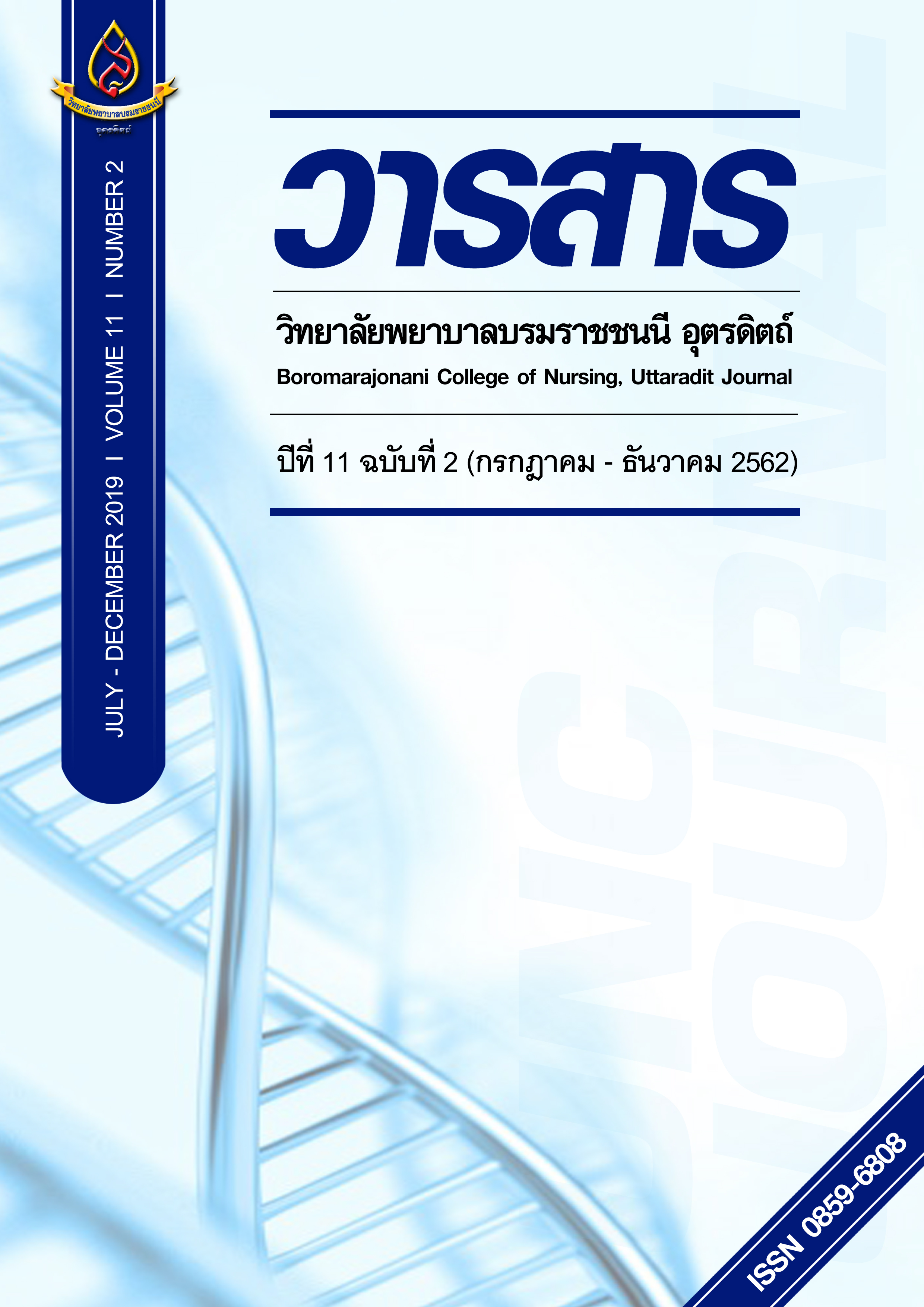ผลของโปรแกรมการพยาบาลระบบสนับสนุนและให้ความรู้ต่อความวิตกกังวล ของสมาชิกครอบครัวผู้ป่วยหนักระบบทางเดินหายใจ โรงพยาบาลอุตรดิตถ์
Main Article Content
บทคัดย่อ
การวิจัยนี้มีวัตถุประสงค์เพื่อศึกษาผลของโปรแกรมการพยาบาลระบบสนับสนุนและให้ความรู้ต่อความวิตกกังวลของสมาชิกครอบครัวผู้ป่วยหนักระบบทางเดินหายใจ โรงพยาบาลอุตรดิตถ์ เป็นการวิจัยกึ่งทดลอง กลุ่มตัวอย่าง คือ สมาชิกครอบครัวผู้ป่วยหนักที่เข้ารับการรักษาในหอผู้ป่วยหนักระบบทางเดินหายใจโรงพยาบาลอุตรดิตถ์ แบ่งเป็นกลุ่มควบคุมและกลุ่มทดลอง กลุ่มละ 30 คน โดยกลุ่มควบคุมได้รับการพยาบาลตามปกติ ในขณะที่กลุ่มทดลองได้รับการพยาบาลโดยใช้โปรแกรมการพยาบาลระบบสนับสนุนและให้ความรู้ จับคู่ให้กลุ่มตัวอย่างทั้งสองกลุ่มมีความคล้ายคลึงกันในเรื่อง เพศ อายุ และ ระดับการศึกษา เครื่องมือที่ใช้ในการวิจัย ประกอบด้วยโปรแกรมการพยาบาลระบบสนับสนุนและให้ความรู้ แบบสอบถามความต้องการและแบบวัดความวิตกกังวลของสมาชิกครอบครัวผู้ป่วยหนักระบบทางเดินหายใจ ซึ่งผ่านการตรวจสอบความตรงตามเนื้อหาและความเชื่อมั่น วิเคราะห์ข้อมูลโดยใช้สถิติเชิงพรรณนา และสถิติทดสอบค่าที
ผลการศึกษาพบว่า กลุ่มทดลอง มีค่าเฉลี่ยคะแนนความวิตกกังวลก่อนการทดลองอยู่ในระดับสูง ( X= 3.21, SD. =0.19) หลังการทดลอง อยู่ในระดับปานกลาง ( X = 2.39, SD. = .13) แตกต่างกันอย่างมีนัยสำคัญทางสถิติ (p =.001) เมื่อเปรียบเทียบความวิตกกังวลของสมาชิกครอบครัวผู้ป่วยหนักระบบทางเดินหายใจ โรงพยาบาลอุตรดิตถ์ ระหว่างกลุ่มทดลองกับควบคุม พบว่ากลุ่มควบคุมและกลุ่มทดลองมีค่าเฉลี่ยคะแนนความวิตกกังวลอยู่ในระดับปานกลาง ( X = 2.84, SD. =.18; = 2.39, SD. =.13) แตกต่างกันอย่างมีนัยสำคัญทางสถิติ (p =.001) แสดงให้เห็นว่าผลของโปรแกรมการพยาบาลระบบสนับสนุนและให้ความรู้ต่อความวิตกกังวลของสมาชิกครอบครัวผู้ป่วยหนักระบบทางเดินหายใจลดความวิตกกังวลของสมาชิกครอบครัว
Article Details
บทความหรือข้อคิดเห็นใดใดที่ปรากฏในวารสารวิจัยการพยาบาลและวิทยาศาสตร์สุขภาพ เป็นวรรณกรรมของผู้เขียน ซึ่งบรรณาธิการหรือสมาคมศิษย์เก่า ไม่จำเป็นต้องเห็นด้วย และบทความที่ได้รับการตีพิมพ์เผยแพร่ถือเป็นลิขสิทธิ์ของวารสารวิจัยการพยาบาลและวิทยาศาสตร์สุขภาพ
References
2) Buasum-ang,P., Binhozen,W., & Pakdeewong, N.(2014). The effectiveness of communication program to family members of critical patients on uncertainty in illness and coping strategies. Journal of Nursing and Health care, 32(4), 76-84. (in Thai).
3) Bureetes, K..(2007). Effect of using of family supporting nursing system intensive care unit on the patients’ family anxiety level: A case study of Chonburi Regional Medical Center Master. (master’s thesis) Faculty of Nursing, Chulalongkorn University, Bangkok. (in Thai).
4) Chareonsuk, P., (2006). Experience of critically ill patients caring of relatives. (Master' s thesis) Faculty of Nursing, Burapha University, Chon Buri. (in Thai).
5) Chinwattana,K., Sen-ngam,K.& Rattasumpun,S.(2013).The effect of preparatory information on level of anxiety in heart patient undergoing transesophagealechocardiography. Retrieved (2017, January 29) from https://www.rsu.ac.th/nurse/download.pdf.
6) Eggenberger SK. Nelms TP. Being family.(2007). The family experience when an adult member is with a critical illness. Journal of Clinical Nursing, 16(9), 1618-28.
7) Khawaraphruek, S., Harnirattisai, E. & Thanasilp,S. (2014). The Effects of a family participation in caring program on intubated patient’s suffering and their family’s anxiety and satisfaction. Nursing Journal, 41(1), 90-108.
8) Khiewchaum, R., & Wattana,C., (2017). Holistic nursing for traumatic brain injury patient.Journal of Phrapokklao Nursing College, 28(1), 129-39.(in Thai).
9) Kongsuwan W, Chaipetch,O. (2011).Thai Buddhists’ experiences caring for family members who die a peaceful death in intensive care. International Journal of Palliative Nursing, 17(7),329-36.
10) Kotpratum,K.(2004). An Adaptation of Family with a Severe Head Injury of a Member Under Hills Family Crisis Model. Journal of Nursing and Health, 27(1), 34-41. (in Thai).
11) Leske JS..(2002) Intervention to decrease family anxiety. Protocols for practice applying research at the bedside. Critical care nurse, 22(6), 61-4.
12) Limumnoiiap, S. & Thamnong C. (2008). Critical care nursing. Khon Kaen: Klangnana – vittaya. (in Thai).
13) McAdam JL, Puntillo KL. Symptom experiences by family members of patients in intensive care units. American Journal of Critical Care 2009, 18(3), 200-10.
14) Medical Statistics unit of Uttaradit Hospital.(2016). Statistical yearbook 2016. Uttaradit: Uttaradit Hospital. (in Thai).
15) Molter NC., & Leske JS. (1986). Critical care family needs inventory. Available form Authors.
16) Murray RB., & Huelskotter MW.. (1991). Psychiatric mental health nursing; giving emotional care. 3rded. California : Appleton and Lange.
17) Orem DE., (2001). Nursing concept of practice. 4th ed. St Louis: Mosky Year Book.
18) Panyasai K. (2010). Effects of information and emotional support on anxiety and satisfaction among family members of patients in general intensive care unit, Lampang Hospital. (Master’s thesis) Faculty of Nursing, Chiang Mai University, Chiang mai (in Thai)
19) Pimsri,M.,& Limumnoilap, S.(2014). Effect of the transferal preparation from the intensive care uniton anxiety of patients with post open heart surgery. (Master’s thesis) Faculty of Nursing, Khon Kaen University, Khon Kaen. (in Thai).
20) Pochard F, Darmon M, Fassier T..(2005). Symptoms of anxiety and depression in family members of intensive care unit patients before discharge or death. A prospective multicenter study. Journal of Critical Care, 20(1), 90-6.
21) Singdong,P., & Jitpanya, C..(2012). Experiences of family members were admitted in intensive care: The qualitative Research. Ramathibodi Nursing Journal, 18(3), 404-17.(in Thai).
22) Spielberger CD.(1972). Anxiety as an emotion state. In Anxiety; Current trends in theory and research. New York : Academic.
23) Srisatidnarakul, B..(2010).The methodology nursing in research. Bangkok: You and intermedia.
24) Srisupha-olarn, I..(2014). The effect of meeting family needs program on anxiety of family members of critically ill patients. (Master's thesis) Faculty of Nursing, Chulalongkorn University, Bangkok (in Thai).
25) Thammarux,T., Chanruangvanich,W., Thosingha,O., & urboonyawat, T..(2017). The Effect of Family Support Program on Copingamong Caregiversof Post operative Neurosurgical Patientsin ICU. Thai Journal of Nursing Council, 32(2), 49-64. (in Thai).
26) Wall RJ. (2009). The one thing certain in the ICU is uncertainty. Critical Care Alert, 17(2), 9-16.
27) Yang S., (2008). A mixed methods study on the needs of Korean familie’s in the intensive care unit. Australian Journal of Advanced Nursing, 25(4), 79-86.

